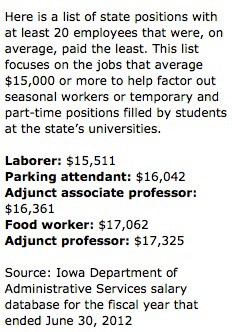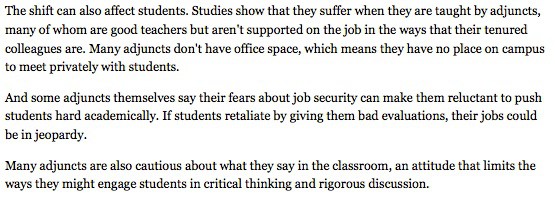
When your teenagers reach college, who will be teaching them?
Chances are excellent that many of your children’s professors will be part-timers or full-time professors without any chance of getting tenured. The number of adjunct professors on college campuses has soared in the past decade. Today only thirty percent of college professors have tenure or are on the tenure track.
The change, according to a recent article in The Chronicle of Higher Education, has been particularly pronounced at mid-tier private universities and at regional state universities.
Adjuncts, who are the workhorses at many campuses, are paid by the course with short-term contracts. Some of these instructors are earning a mere $2,500 or $3,000 a course, which should make some of them eligible for food stamps.
The Des Moines Register, which recently examined salaries of Iowa state employees, concluded that two of the five lowest salaried employees were adjunct professors at Iowa public universities. As you can see below these professors, many of them with PhDs, are getting paid comparable to parking attendants and cafeteria workers.
The Impact of Adjunct Professors
Adjunct professors can be better teachers than tenured professors, who enjoy lifetime job security, sabbaticals, health care and sometimes few teaching responsiblities. There are plenty of reasons why you should care that highly educated yet exploited adjunct professors are a growing presence on college campuses. A recent in-depth story on adjunct professors in The Chronicle of Higher Education discussed how adjunct’s tenuous employment realities can negatively impact students:
Bottom Line:
When you are researching colleges and universities, ask about the presence of adjunct professors on the campus. I believe how institutions treat their professors does matter, not only to the faculty but the students as well.
Also, if your child has dreams of becoming a college professor, please tell them to explore the ugly realities of this profession.
Learn more on The College Solution:
What is Your Expected Family Contribution?
The Weakest Link in the College Admission Process
Where to Find the Best College Professors
Lynn O’Shaughnessy is the author of The College Solution: A Guide for Everyone Looking for the Right School at the Right Price.



Also note that many times at universities have graduate students teaching classes, and those numbers won’t come up on the adjunct vs tenure ratios, and they can be worse as they’re trying to get whatever research done for their degree, often teach not because they want to but because it helps with tuition, and can have a superiority complex towards the “lowly” freshmen… trust me I was one of them I know.
One issue I often see with adjuncts is their lack of availability outside the classroom. When they are teaching at multiple schools or working another job, it can be very difficult for them to have time to meet with students.
Hi Lynn,
Your article is getting great response from adjunct groups online, blogs and Facebook pages. I have to apologize though for somehow alliterating you into a Sheila (no Oz pun intended). I added a correction but not before it reached the twittiverse…fortunately with blog name and link intact, we owe you reparations, I’m thinking shares, RTs and such.
Debra Leigh Scott also has useful posts such as What We Must Demand of Our Colleges
Thanks Vanessa. I am putting your link in today’s post. This is such an important topic!
Lynn O’Shaughnessy
Hi Lynn,
As we narrowed down our son’s search, one way we found to get at this issue was to look up the actual course schedules and see who is teaching. If there are a lot of names that don’t show up on the department’s faculty list (or related departments) they’re probably using adjunct faculty.
The numbers alone don’t always explain the situation. In the case of Beloit, the Academic Workforce Summary Data shows a quarter of faculty as being full- or part-time non-tenure track faculty. That doesn’t mean a quarter of the classes are being taught by adjunct faculty. Of the 15 classes offered in the history department this semester, only one was being taught by non-tenured track faculty.
Another consideration is more relevant to medical fields but I think is showing up more in business and engineering, professionals in the field who are teaching a class. Of course, it all depends on the individual as to how useful the practical experience is to the students.
I completely agree that are way too many adjunct faculty and both students and faculty suffer because of it. Anytime there is concentration of adjuncts in a department, you have to question the school’s commitment to the quality of the student’s education and wonder where it does put its money.
Hi Lynn,
Thanks for writing this important article. I’m the editor of a website called the Adjunct Project, which is dedicated to exposing this hidden truth on college campuses. Awhile back, I wrote a post for a parent who asked me how she could get more informed on behalf of her college-bound daughter. New Faculty Majority and the MLA Academic Workforce Data are both good places to start: Quick Reference Guide For Parents on the College Search.
Thank you for covering this and advising parents to include workplace conditions and staffing ratios in their research.
Fwiw, the New Faculty Majority has parents and students sections on our website, http://www.newfacultymajority.info/equity/
Hi Vanessa,
Thanks so much for letting me know about this great website for people wanting to know more about issues involving adjunct professors. Through your website I found a great search tool that families can use when researching just how many adjuncts are teaching at individual universities and colleges. Here is the link: http://www.mla.org/acad_work_search
Lynn O’Shaughnessy